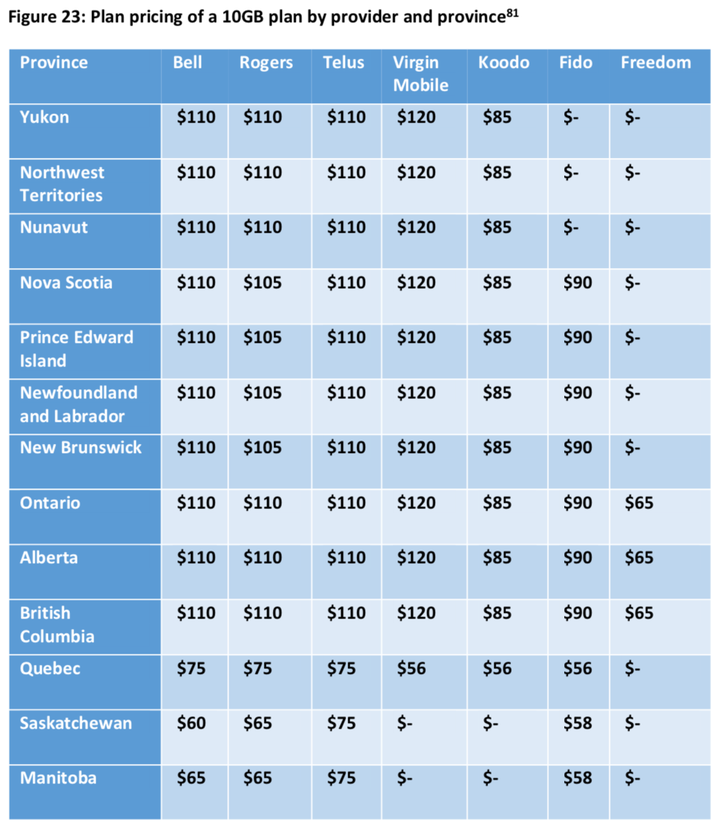
Canadians pay some of the highest wireless rates in the world, and advocates say the key to bringing down prices is opening the door to more competition.
It’s a theory that has been pushed by advocacy groups such as OpenMedia, which have been pushing the federal government to do more to help Canadians with their phone bills.
“It’s a no-brainer; more competition, lower prices, more affordability,” OpenMedia digital rights campaigner Marie Aspiazu told HuffPost Canada.
Studies repeatedly show that Canadians pay a premium for their wireless service. In fact, a report published earlier this year by Sweden-based firm Tefficient suggests that Canadian carriers earn more revenue per gigabyte (GB) than any other country in the world.
The Competition Bureau submitted a report last week to the Canadian Radio-television and Telecommunications Commission (CRTC) on ways to lower prices for wireless consumers. The independent government agency included figures showing the difference in wireless costs for Canadians depending on where they live.
“We are making the case for increased competition in the wireless sector to lower prices and increase choice on services that Canadians depend on,” Competition Bureau commissioner Matthew Boswell said in a May 16 news release.
Watch: Here’s what you need to know about data-only cellular plans. Story continues below.
The agency points to Quebec, Manitoba and Saskatchewan as examples of areas benefitting from the presence of strong regional competitors, such as Vidéotron and Sasktel.
Across most of Canada, 10GB wireless plans range from $85 to $120 per month.
But in Quebec, Fido, Koodo and Virgin Mobile offer 10GB wireless data plans for as low as $56 a month. Fido also offers plans for as little as $58 in Manitoba and Saskatchewan. Even the Big Three (Rogers, Bell, and Telus) offer better deals in these provinces, with 10GB monthly plans ranging from $60 to $75.
“They’re paying like half for the same plans,” Aspiazu said. “What it really boils down to is the regional competitor.”
So what needs to happen to bring down costs for consumers? After all, it’s not so easy to start a telecommunications company in Canada, especially without the proper infrastructure in place. Plus, the Big Three account for around 90 per cent of the wireless market.
That’s why consumer groups are calling on the federal government to allow more mobile virtual network operators (MVNOs) in Canada. MVNOs already operate in Canada to a limited extent, but the CRTC could decide to mandate access. Essentially, this regulatory move would allow smaller players to lease network space from the Big Three, which would allow them to sell plans and compete with other players in the industry.

“It is ridiculous to expect that a new competitor comes into the country and has to build their own infrastructure to compete with the Big Three, which has been receiving years-worth of government subsidies to build that infrastructure,” Aspiazu said.
The advocate added that “people are not happy with the Big Three” because “the market concentration is really high.” Opening the door to MVNOs would lead to more competition that would drive down prices, allowing Canadians to “find a provider that meets their needs,” she continued.
Major wireless competitors in Canada say they are opposed to the idea of MVNOs. They say it may not guarantee the desired effect of lower costs for consumers.
“What research we have today suggests, consistently, that MVNOs have had no statistically significant impact on retail prices, particularly low cost tariffs, despite the many claims of potential MVNOs to the contrary,” stated a report prepared for Rogers Communications.
Bell warned that allowing MVNOs would reduce investment in telecoms, writing the following in their CRTC submission:
“Wireless carriers invest in their networks in order to be able to offer speed, coverage, or other quality and service attributes that give them an advantage over other carriers in competitive markets. Forced resale eliminates that advantage and with it the primary rationale for investment.”
Regulation could be risky
SaskTel, a smaller competitor, also opposes the idea of bringing MVNOs to Canada, claiming that studies show no link between the regulation and lower prices.
“The current regulatory regime is working as intended and no further action is necessary,” SaskTel wrote in their report to the CRTC, citing concerns over cost. “If the Commission now changes the regulatory rules, it is these growing, but still vulnerable, carriers who will feel the brunt of the impact.”
The CRTC has heard and rejected this regulatory option before. In 2015, the commission opted against implementing MVNOs “due to concerns that doing so would undermine investment in spectrum and networks by facilities-based wireless carriers, particularly competitors.”
Even the Competition Bureau, which is calling for more competition in the marketplace, is not entirely sure about the best path forward.
“While mandated MVNO access may be a warranted next step, there are both potential benefits and potential risks of regulatory intervention,” the Bureau wrote. “Whether mandated MVNO access is the best way to foster competition in Canada’s retail wireless market is not clear at this stage in this proceeding.”
But there appears to be pressure building for real change in the marketplace.
“We’re working hard to bring down the cost of cellphone plans,” federal Innovation Minister Navdeep Bains said in a statement last December.
Critics will soon shift their attention toward the highly anticipated CRTC review of mobile wireless services, which is set for January. The review will focus on retail competition, the future of wireless services in Canada and the possibility of implementing wholesale MVNO access.
“In recent years, the Commission has found it necessary to intervene in the retail market because of concerns that this market may not be meeting the needs of Canadians,” the CRTC wrote.
Advocates are hopeful that this will be the review that brings about meaningful change to the wireless industry.
Aspiazu told HuffPost there’s a chance that some Canadians can see even lower wireless costs than the cheapest currently available in Canada if MVNOs are mandated.
“I think we can even go a little bit lower than that.”